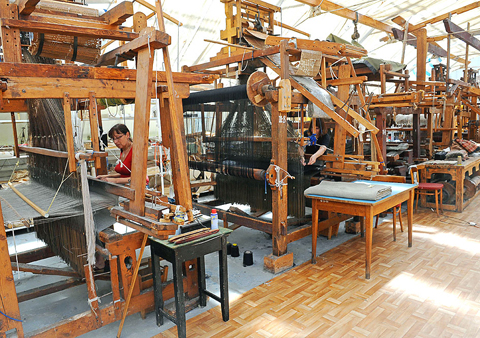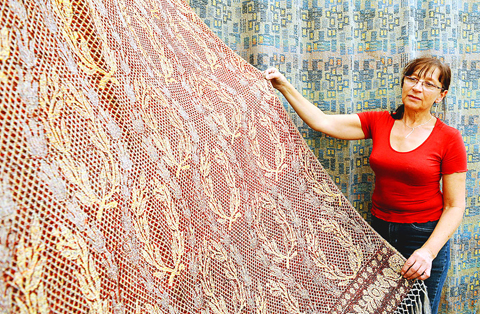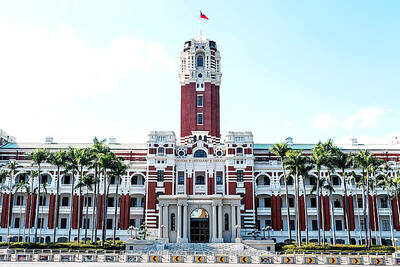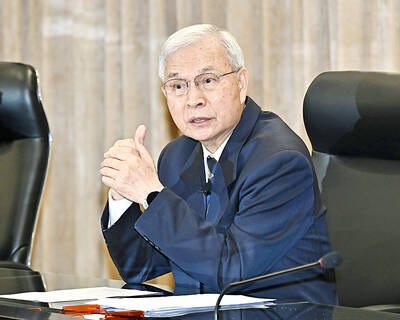The rhythmic clickety-clack of 19th-century hand looms will soon be silenced when what is thought to be the last Jacquard workshop in Europe closes in a few weeks and another traditional art disappears.
Film makers, theaters and interior designers have been keeping the LAD Jacquard fabric workshop in Warsaw alive but the economic crisis has hit all of them very hard.
“We’re in a very difficult economic situation and in a few weeks this, the oldest working Jacquard manufacturer in Europe, will become history,” said Dariusz Makowski, owner of the workshop.

PHOTO: AFP
Makowski is pessimistic that public subsidies can be found.
Invented by Frenchman Joseph Marie Jacquard in the French city of Lyon around 1800, the Jacquard loom was the first to weave complicated patterns. It revolutionized textile manufacturing and paved the way for the mechanized modern textile industry.
“It allowed fabrics with beautiful, intricate designs to be produced much faster and at a much lower cost,” Makowski said.

PHOTO: AFP
“In fact in the 1820s it sparked a labor movement by weavers in Lyon, a great social revolution and the rise of the weavers’ Solidarity union in 1823 to 1825 — much, much sooner than in Poland,” he remarked of the rise of Poland’s historic Solidarity union led by Nobel Prize winner Lech Walesa in 1980.
The Jacquard technique spread across Europe in the 1800s and by the 1840s large manufacturing facilities weaving Jacquard fabrics and rare laces were set up in Poland. But soon machine-operated Jacquard looms replaced their hand-operated ancestors.
“In 1926 they [the hand looms] became the property of the Warsaw Fine Arts academy and later the LAD artists’ co-operative was created. We are their successors,” Makowski said.

PHOTO: AFP
“This is the only remaining working cooperative of the famous ones such as Bauhaus in Germany or the Arts and Crafts Society in London,” he said.
Fifteen years ago he bought 12 19th-century wooden Jacquard looms and an inventory of 509 antique Jacquard patterns from the LAD cooperative which folded in post-communist Poland’s difficult adaptation to the market economy.
Today, the workshop is located in a ramshackle greenhouse in Warsaw’s sprawling Royal Lazienki park.
The revolutionary Jacquard loom was the first to use special punch-hole cards using a binary code to make fabric patterns using a steering mechanism on the top of the loom.
“The machine on top of the loom can be likened to a computer while the punch-card is like a kind of primitive computer program or disc,” said veteran weaver Mariola Nowakowska, 54, who has been working on looms for 30 years.
“The machine reads the punch-card and really you could say it’s a kind of a proto-computer,” she said.
A weaver on a Jacquard hand loom must be physically fit to pump its heavy wooden pedal day in, day out and have the patience of a saint to make sure each of several thousand fine threads is in its rightful place, Nowakowska said.
But the effort is rewarded by the special quality of the product.
“On hand looms fabrics are naturally more supple and light than mechanically made ones as we compact the weave by hand and we don’t have as much strength as the motor running a machine,” Nowakowska said.
An experienced weaver can produce up to 2m of Jacquard cloth per day, but Nowakowska is one of the last possessing the skill to deftly operate a Jacquard loom.
“Essentially, this craft has disappeared. We are just two weavers here and young people just aren’t interested in learning. It’s hard, complicated work. Perhaps there will be someone willing to learn, if not, it will become a museum,” Nowakowska said with a hint of sadness.

The CIA has a message for Chinese government officials worried about their place in Chinese President Xi Jinping’s (習近平) government: Come work with us. The agency released two Mandarin-language videos on social media on Thursday inviting disgruntled officials to contact the CIA. The recruitment videos posted on YouTube and X racked up more than 5 million views combined in their first day. The outreach comes as CIA Director John Ratcliffe has vowed to boost the agency’s use of intelligence from human sources and its focus on China, which has recently targeted US officials with its own espionage operations. The videos are “aimed at

STEADFAST FRIEND: The bills encourage increased Taiwan-US engagement and address China’s distortion of UN Resolution 2758 to isolate Taiwan internationally The Presidential Office yesterday thanked the US House of Representatives for unanimously passing two Taiwan-related bills highlighting its solid support for Taiwan’s democracy and global participation, and for deepening bilateral relations. One of the bills, the Taiwan Assurance Implementation Act, requires the US Department of State to periodically review its guidelines for engagement with Taiwan, and report to the US Congress on the guidelines and plans to lift self-imposed limitations on US-Taiwan engagement. The other bill is the Taiwan International Solidarity Act, which clarifies that UN Resolution 2758 does not address the issue of the representation of Taiwan or its people in

US Indo-Pacific Commander Admiral Samuel Paparo on Friday expressed concern over the rate at which China is diversifying its military exercises, the Financial Times (FT) reported on Saturday. “The rates of change on the depth and breadth of their exercises is the one non-linear effect that I’ve seen in the last year that wakes me up at night or keeps me up at night,” Paparo was quoted by FT as saying while attending the annual Sedona Forum at the McCain Institute in Arizona. Paparo also expressed concern over the speed with which China was expanding its military. While the US

SHIFT: Taiwan’s better-than-expected first-quarter GDP and signs of weakness in the US have driven global capital back to emerging markets, the central bank head said The central bank yesterday blamed market speculation for the steep rise in the local currency, and urged exporters and financial institutions to stay calm and stop panic sell-offs to avoid hurting their own profitability. The nation’s top monetary policymaker said that it would step in, if necessary, to maintain order and stability in the foreign exchange market. The remarks came as the NT dollar yesterday closed up NT$0.919 to NT$30.145 against the US dollar in Taipei trading, after rising as high as NT$29.59 in intraday trading. The local currency has surged 5.85 percent against the greenback over the past two sessions, central